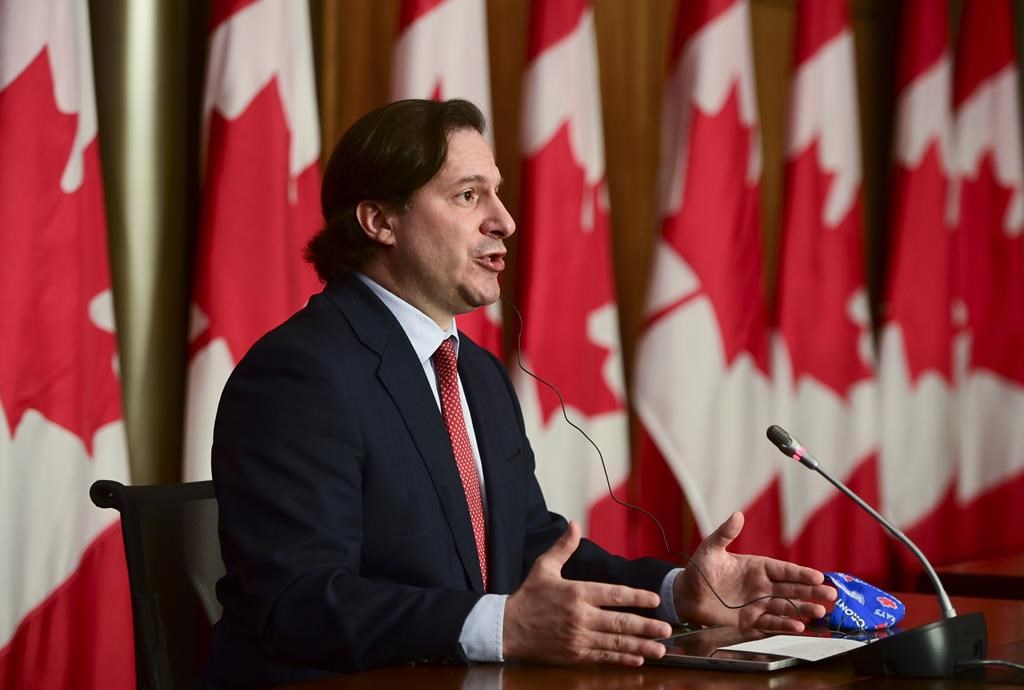WASHINGTON — Canada’s immigration minister talked Canada-U.S. border issues Monday with the secretary of the U.S. Department of Homeland Security.
But the federal government’s official account of the meeting between Marco Mendicino and Alejandro Mayorkas, released late Tuesday, makes no mention of the current imbalance in travel between the two countries.
The readout does say that the pair discussed managing what it calls a “secure border that allows for necessary travel as pandemic border restrictions begin to ease.”
Monday marked the first day in nearly 17 months that U.S. citizens and permanent residents who are fully vaccinated were allowed to visit Canada.
Eligible American visitors to Canada must have allowed 14 days to pass since their last dose of a Health Canada-approved vaccine, and must also show proof of a recent negative test for COVID-19.
The U.S., however, still won’t let Canadians, vaccinated or otherwise, cross the land border to enter the U.S. for non-essential purposes.
Ottawa’s readout describes the meeting between the two leaders “as a continuation of their first call” in June.
They “discussed their ongoing commitment to protecting the integrity of our shared North American perimeter,” it says, “and to managing a secure border that allows for necessary travel as pandemic border restrictions begin to ease.”
The meeting was billed as a next-steps followup to the commitments Prime Minister Justin Trudeau and President Joe Biden made in February when they forged a “road map” for a renewed bilateral partnership.
That agreement specifically calls for “co-ordinated border policies” that keep the virus and its variants in check “while promoting economic growth and recovery.”
Despite that, the traffic over the Canada-U.S. border was markedly one-way Monday, leading to lengthy delays of several hours at some border crossing locations unaccustomed to high numbers of travellers. Those holdups had all but disappeared by 7 p.m. ET Tuesday.
Monday’s discussion also included global migration and refugees — “in particular, addressing the sources and challenges of forced displacement and irregular migration in Central America,” the readout said.
Ottawa says Mendicino also spent his time in Washington talking about immigration and post-pandemic growth at the Migration Policy Institute and the World Bank.
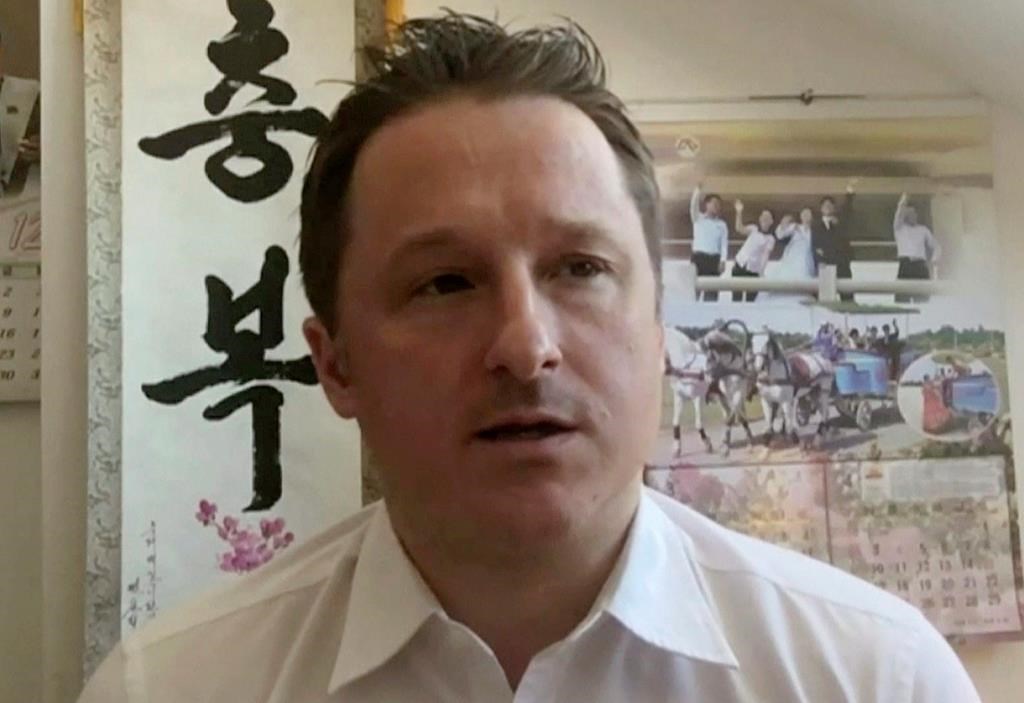
A Canadian entrepreneur was sentenced to 11 years in prison Wednesday in a spy case linked to Beijing’s effort to push his country to release an executive of tech giant Huawei, prompting an unusual joint show of support for Canada by the United States, Japan and 23 other governments.
China is stepping up pressure as a Canadian judge hears final arguments about whether to send the Huawei executive to the United States to face charges related to possible violations of trade sanctions on Iran. On Tuesday, a court rejected another Canadian’s appeal of a death sentence in a drug case that was increased after the executive’s arrest.
Entrepreneur Michael Spavor and a former Canadian diplomat were detained in what critics labeled “hostage politics” after Huawei’s Meng Wanzhou, was arrested Dec. 1, 2018, at the Vancouver airport.
Spavor was sentenced by a court in Dandong, about 210 miles (340 kilometers) east of Beijing on the North Korean border. The government has released few details other than to accuse Spavor of passing along sensitive information to the former diplomat, Michael Kovrig, beginning in 2017. Both have been held in isolation and have little contact with Canadian diplomats.
Prime Minister Justin Trudeau issued a statement following the verdict, calling it “absolutely unacceptable and unjust.”
“Today’s verdict for Mr. Spavor comes after more than two and a half years of arbitrary detention, a lack of transparency in the legal process, and a trial that did not satisfy even the minimum standards required by international law,” the statement read. “For Mr. Spavor, as well as for Michael Kovrig who has also been arbitrarily detained, our top priority remains securing their immediate release. We will continue working around the clock to bring them home as soon as possible.”
“Our thoughts, and the thoughts of all Canadians, are with Mr. Spavor and his loved ones during this incredibly difficult time. The Government of Canada continues to provide consular assistance to Mr. Spavor and his family as we work to secure his safe return.”
The legal process in Spavor’s case “lacked both fairness and transparency,” said Ambassador Dominic Barton outside a detention center where the sentence was announced.
Spavor has two weeks to decide whether to appeal, according to Barton.
“While we disagree with the charges, we realize that this is the next step in the process to bring Michael home and we will continue to support him through this challenging time,” Spavor’s family said in a statement.
“Michael’s life passion has been to bring different cultures together through tourism and events shared between the Korean peninsula and other countries including China and Canada,” his family said. “This situation has not dampened, but strengthened his passion.”
In a statement, Foreign Affairs Minister Marc Garneau condemned China’s conviction and sentencing of Spavor “in the strongest possible terms.”
“We have maintained for more than two and a half years that the detentions of Michael Spavor and Michael Kovrig are completely arbitrary. These concerns have been echoed by many other countries who continue to voice their support for these Canadians.”
Garneau thanked those countries that have called for the release of Canadian citizens arbitrarily detained in China.
Diplomats from the United States, Japan, Britain, Australia, Germany and other European countries plus the European Union gathered at the Canadian Embassy in Beijing in a show of support. They also have issued separate appeals for Spavor and Kovrig to receive fair trials or to be released.
“These proceedings are a blatant attempt to use human beings as bargaining leverage,” the top American diplomat in China, David Meale, said in a statement. “Human beings should never be used as bargaining chips.”
Meng, the chief financial officer of Huawei Technologies Ltd. and daughter of the company’s founder, was arrested on U.S. charges of lying to the Hong Kong arm of the British bank HSBC about possible dealings with Iran in violation of trade sanctions.
Meng’s lawyers argue the case is politically motivated and what she is accused of isn’t a crime in Canada.
China’s government has criticized the arrest as part of U.S. efforts to hamper its technology development. Huawei, a maker of network equipment and smartphones, is China’s first global tech brand and is at the center of U.S.-Chinese tension over technology and the security of information systems.
Beijing denies there is a connection between Meng’s case and the arrests of Spavor and Kovrig, but Chinese officials and state media frequently mention the two men in relation to whether or not Meng is allowed to return to China.
Earlier, Barton said he didn’t think it was a coincidence the cases in China were happening while Meng’s case was advancing in Vancouver.
Asked whether Canada was negotiating over possibly sending Meng home in exchange for the release of detained Canadians, Barton said, “there are intensive efforts and discussions. I don’t want to talk in any detail about that. But that will continue.”
Canada and other countries including Australia and the Philippines face trade boycotts and other Chinese pressure in disputes with Beijing over human rights, the coronavirus and control of the South China Sea. The United States has warned American travelers face a “heightened risk of arbitrary detention” in China for reasons other than to enforce laws.
Diplomats from the United States and Germany went to the detention center in Dandong but weren’t allowed in, according to Barton.
“Our collective presence and voice send a strong message to China and the Chinese government that the eyes of the world are watching,” the ambassador said.
Barton said Chinese authorities cited photos taken by Spavor at airports that included military aircraft.
“A lot of it was around the photo evidence,” the ambassador said. “He obviously had a different view on that.”
Barton met with Spavor after the sentencing and said he sent three messages: “Thank you for all your support, it means a lot to me. Two, I am in good spirits. And three, I want to get home.”
“He’s strong, resilient, focused on what’s happening,” Barton said. “We had a very good conversation.”
Kovrig, who also was detained in December 2018, stood trial in March. There has been no word on when a verdict might be announced.
The Canadian Embassy noted Spavor had been held for 975 days as of Wednesday.
Spavor worked in China but had extensive links with North Korea in tourism and other commercial ventures that brought him into contact with the isolated communist state’s leadership.
On Tuesday, a Chinese court rejected the appeal of Robert Schellenberg, whose 15-year prison term for drug smuggling was abruptly increased to death in January 2019 following Meng’s arrest. The case was sent to China’s supreme court for a mandatory review before it can be carried out.
China has tried to pressure Trudeau’s government by imposing restrictions on imports of canola seed oil and other products from Canada.
Meanwhile, Beijing is blocking imports of Australian wheat, wine and other products after its government called for an investigation into the origin of the coronavirus pandemic.
With files from The Canadian Press.
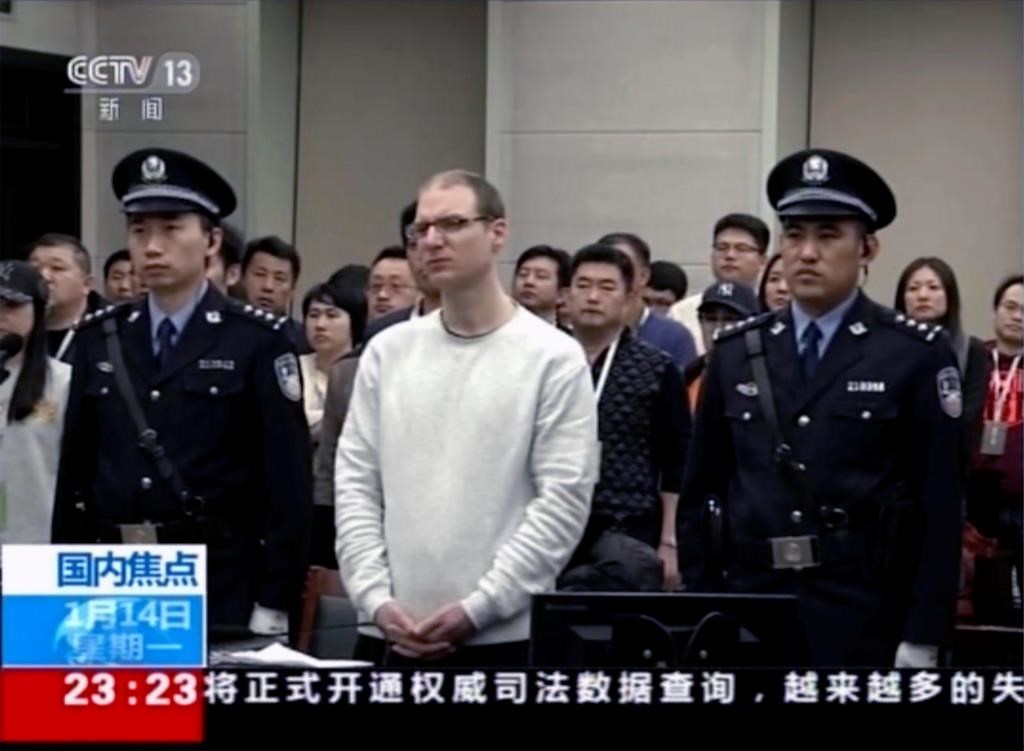
BEIJING — A Chinese court on Tuesday rejected an appeal by Robert Schellenberg, a Canadian whose sentence in a drug case was increased to death after an executive of tech giant Huawei was detained in Vancouver.
Schellenberg was sentenced to prison in November 2018 after being convicted of drug smuggling. He was abruptly resentenced to death in January 2019 while the Chinese government was trying to pressure Canada to release the chief financial officer of Huawei Technologies Ltd. Meng Wanzhou had been detained on U.S. charges related to possible dealings with Iran.
The Higher People’s Court of Liaoning Province rejected Schellenberg’s appeal and said in a statement the sentence was appropriate and the lower court’s procedures legal. It sent the case to the Chinese supreme court for review, as is required by law before any death sentences can be carried out.
Canada’s Minister of Foreign Affairs, Marc Garneau, has issued a statement denouncing the decision.
“We have repeatedly expressed to China our firm opposition to this cruel and inhumane punishment and will continue to engage with Chinese officials at the highest levels to grant clemency to Mr. Schellenberg,” he writes.
“We oppose the death penalty in all cases, and condemn the arbitrary nature of Mr. Schellenberg’s sentence. Global Affairs Canada will continue to provide consular services to Mr. Schellenberg and his family.”
The Chinese government also arrested a former Canadian diplomat, Michael Kovrig, and a Canadian entrepreneur, Michael Spavor, on unspecified spying charges in an apparent attempt to pressure Ottawa to release Meng.
Two other Canadians, Fan Wei and Xu Weihong, also were sentenced to death on drug charges in 2019 as relations between Beijing and Ottawa deteriorated.
The United States wants the Huawei executive, Meng, who is the company founder’s daughter, extradited to face charges she lied to banks in Hong Kong in connection with dealings with Iran that might violate trade sanctions.
A Canadian judge is due to hear final arguments over whether Meng should be extradited.
China also has reduced imports from Canada.
With files from Lisa Steacy
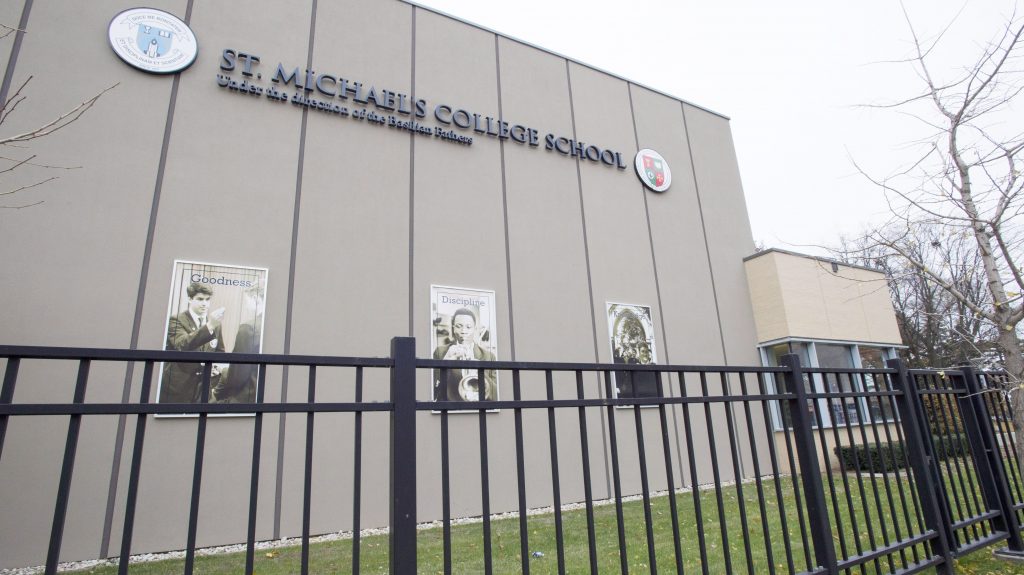
A teen found guilty of sexually assaulting another student at an all-boys school in Toronto is set to have a sentencing hearing today.
A judge found the teen guilty of gang sexual assault, sexual assault with a weapon and assault after a boy was sodomized with a broom handle in a locker room at St. Michael’s College School after a football game.
The teen’s lawyer argued his client feared he’d become the victim of a sexual assault if he didn’t hold his friend’s arm down on Nov. 7, 2018.
The incident was captured on cellphone video and shared widely on social media before police launched an investigation, which sparked a national discussion on hazing in youth sports.
The judge didn’t buy the accused teen’s argument and said he could have chosen not to participate.
None of the minors involved can be named due to provisions under the Youth Criminal Justice Act.
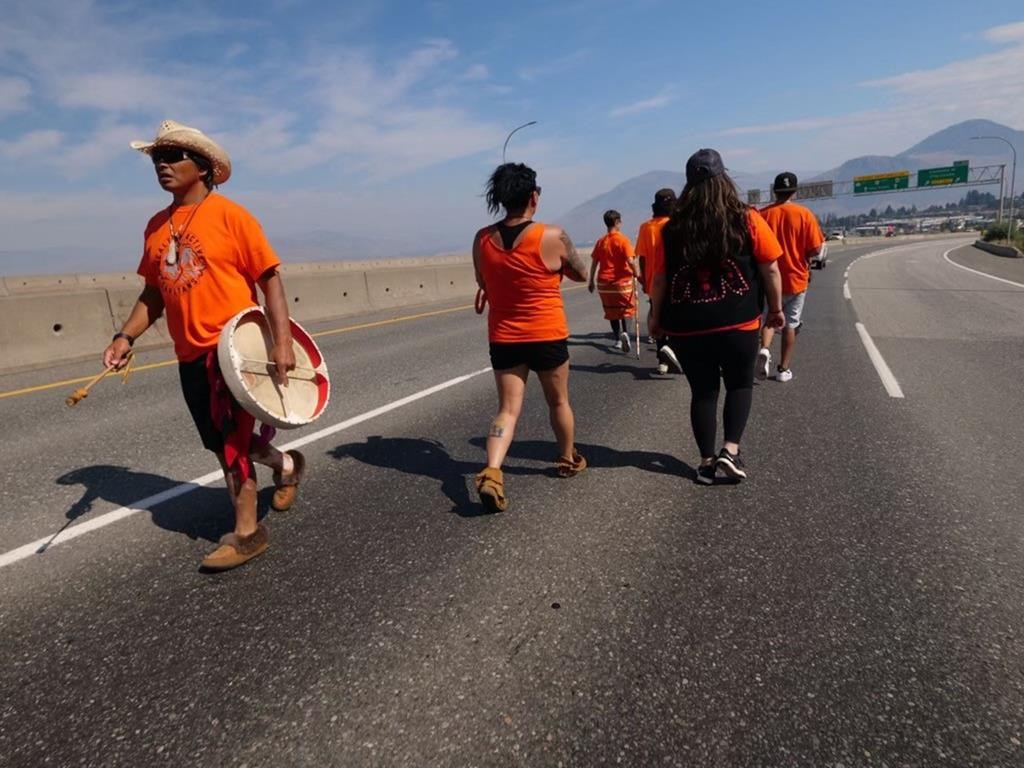
KAMLOOPS, B.C. — A six-week, 2,000-kilometre walk to honour children and survivors of residential schools that began in Yukon ended Monday in Kamloops, B.C., “ground zero for where the truth broke out,” says the man behind the Warriors Walk for Healing Nations.
When Jamie Henyu heard about the discovery of what are believed to be the remains of more than 200 children on the grounds of the former Kamloops Indian Residential School in May, he wondered how he could honour them and survivors of the state-sponsored institutions.
“That was our goal when we started out, is that we walk and honour all the kids that have been found, all the kids that have not been found, and all the survivors out there,” Henyu said in an interview from the community of Bonaparte, where a group of about 17 walkers was taking a break before continuing to Kamloops.
Henyu said he originally thought he’d be walking alone, starting from Telegraph Creek in the northwestern corner of B.C., but support from the Northern Nations Alliance led the walk and fundraising effort to start in Whitehorse in late June instead.
A welcoming event hosted by the Tk’emlúps te Secwépemc Nation took place Monday in Kamloops, their final stop, where a sea of people wearing orange shirts were gathered.
Numerous Indigenous nations have reported finding unmarked graves using the same ground-penetrating radar technology that the Tk’emlúps te Secwépemc used in their investigation in Kamloops.
The walking group grew as it stopped in many communities along the way, said Henyu, who is a member of the Tahltan Nation. Their support vehicles were painted with orange handprints and adorned with signs and flags of participants’ home nations.
“I did have a vision at the end where I was going have a lot of people behind me, but in between the start and the finish, I thought it would be just me,” he said. “Things change and it’s awfully wonderful having everybody here who’s walking with me.”
Corinna Yuill said she’s known Henyu for years and felt she needed to be part of the journey. She was joined by her husband, who was driving the family’s RV, and their 18-year-old son, who participated in his wheelchair.
“I grew up in a community with three reservations and it’s very personal to me, that the people I know have all been affected by residential school,” Yuill said in an interview. “It’s a big part of our life and I walk for everybody, for every child, every woman, every man, every elder, every survivor, every one of our people that suffer.”
Henyu said he walked more than 80 kilometres one day before group members decided to take turns walking in 10-kilometre stretches to conserve energy.
Just about every Indigenous community on their journey south invited the group in for food, housing, singing, storytelling and support, he said.
“Them coming out and telling us their story about residential school and helping them to start healing is so beautiful,” Henyu said of people they’ve met.
The group has also encountered people “on the side of the road who had no idea about residential school, and the conversation ended in tears,” Yuill said.
The walking family is now getting ready to say emotional goodbyes, said Henyu.
“It’s getting so real that this is almost over and when we started it felt like we’ll never get to this point, but here we are now. It’s amazing and scary at the same time.”
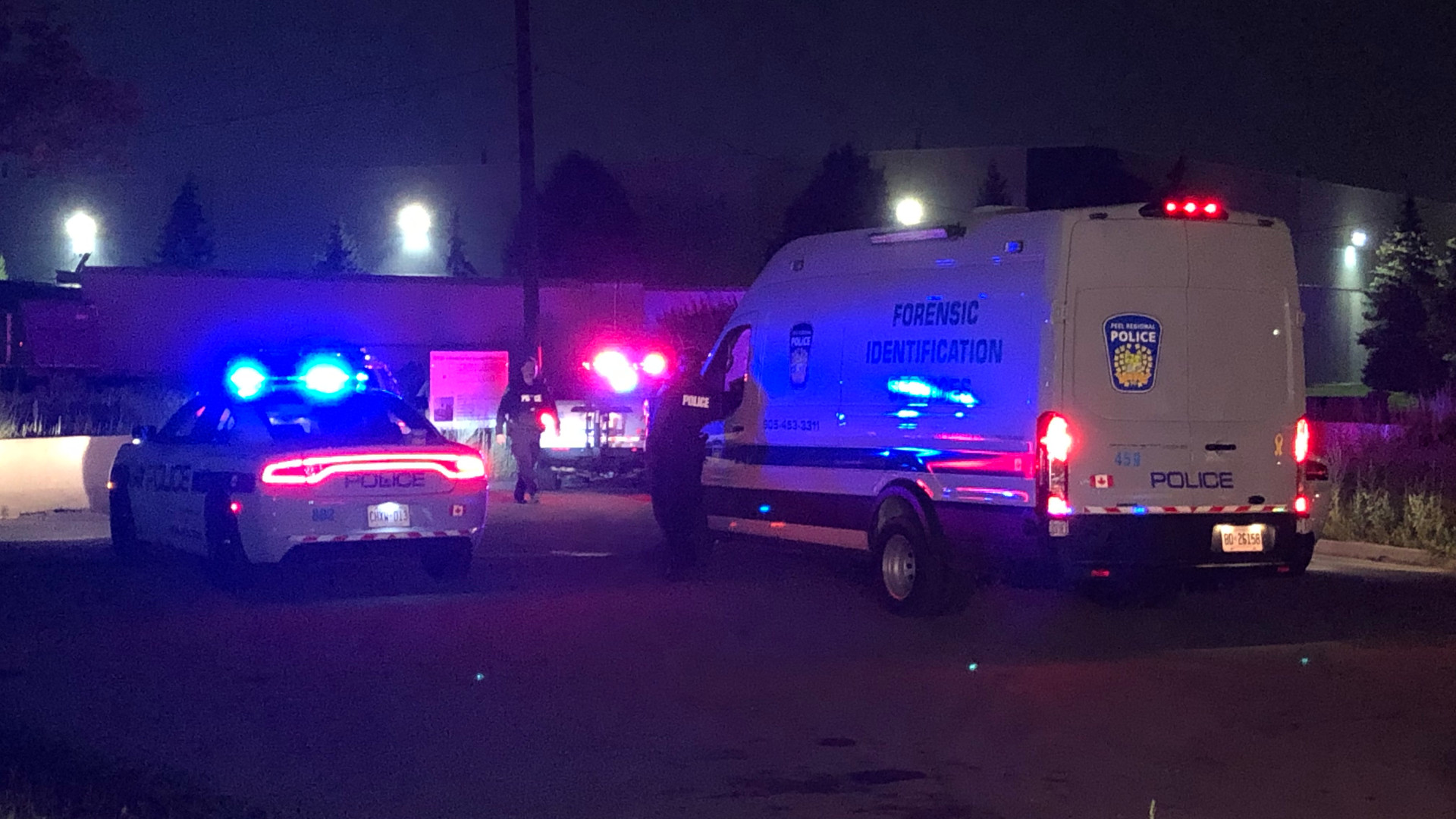
Police are appealing for information following a triple shooting in Mississauga.
Investigators were called to an industrial area near Hurontario Street and World Drive, just north of Highway 401 around 9 p.m. following reports of multiple shots being fired.
They initially did not find any victims when they arrived at the scene, however, they were contacted by one individual away from the crime scene. Two other people then showed up at a nearby hospital suffering from gunshot wounds.
“What we know so far is that there was a house party happening at a residence in this area with up to 100 people in attendance,” said Const. Akhil Mooken. “When officers arrived, they spoke with eight people … so we know there’s about 92 people out there that have not yet had the opportunity to speak to our investigators.”
Police say two women are being treated in hospital for non-life threatening injuries while a man has been taken to a trauma centre, but his injuries are also considered non-life threatening.
Police say the suspects fled the scene but there was no immediate description.
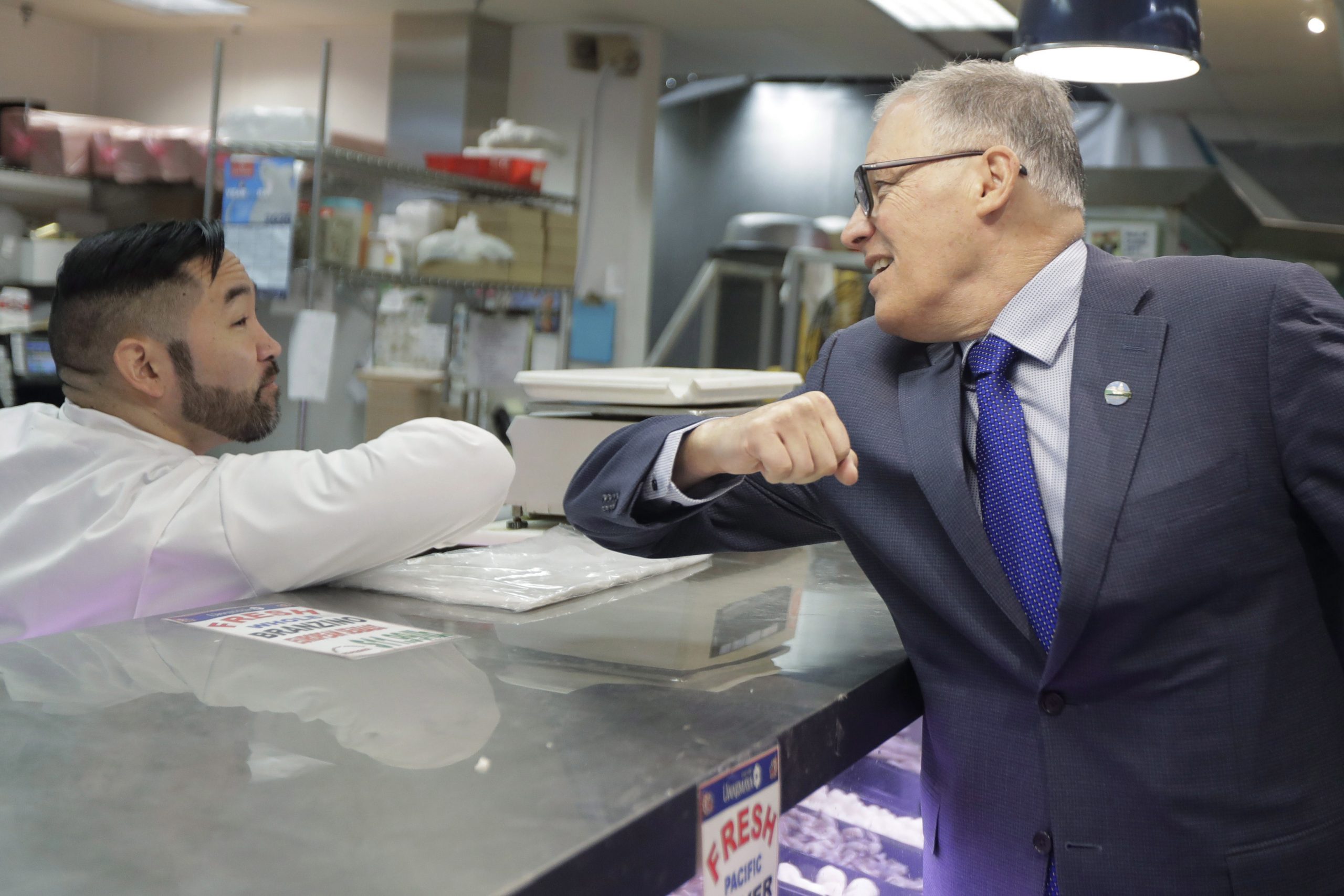
As the pandemic took hold, a Kansas City-area meeting and event planning business began hawking “I Shake Hands” stickers to help ease awkward social encounters.
“We didn’t want the sticker to say, `We Don’t Shake Hands’ because that is kind of off-putting,” said John DeLeon, vice president of operations and sales at MTI Events, adding that the idea was that anti-shakers could simply choose not to wear one of the stickers. “But if someone had the sticker on in that group, then that was the indication that it was OK.”
Now, as workers return to the office, friends reunite and more church services shift from Zoom to in person, this exact question is befuddling growing numbers of people: to shake or not to shake?
The handshake has been around for centuries. A widely held belief is that it originated to prove to someone that a person was offering peace and not holding a hidden weapon. But hands can be germy – coated with fecal matter and E. coli.
Dr. Anthony Fauci, a leading infectious disease expert in the United States, cautioned last year, “I don’t think we should ever shake hands ever again, to be honest with you.”
On the other side is Dr. Amesh Adalja, an infectious disease specialist at Johns Hopkins University. He thinks the whole shaking controversy is overblown. The solution, he says, is simple: “If you are worried about COVID, the best way to make handshakes safe is to be fully vaccinated. And for any other things that might be on people’s hands, just wash your hands before you touch your face. That is what hand sanitizer is for.”
The greeting is almost instinctual and hard to deny. But remote workers who have been holed up in makeshift kitchen and bedroom offices have been denied it for months. Meetings, birthdays, retirement parties and even funerals have been shifted onto Zoom. The loss of connections has been heartbreaking, and the resurgence of the delta variant is raising fresh questions about the return to something resembling normal.
DeLeon isn’t sure the handshake is ever coming back. The stickers his company sold were never hot sellers. Other companies hawked signs and stickers that more firmly discouraged handshaking – including one featuring a skeleton hand and another covered with COVID-19 germs.
“I played golf with a guy the other day, who I had never met and we got along really well. And on the 18th green it is traditional that you stick your hand out and you take your hat off and you shake hands with who you played with,” he said. “And we just kind of stared at each other and fist-bumped and walked off.”
Not so fast, say etiquette experts and businesspeople like Dave McClain, 52, of Overland Park, Kansas. McClain recalls coming across one of the “I Shake Hands” stickers at a networking event and slapping it onto his shirt.
“You can make phone calls all you want and you can meet with people online via Zoom call but it is just not the same as being able to reach out your hand and shake their hand, look them in the eye and really establish that rapport,” he said.
Diane Gottsman, a national etiquette expert and author of “Modern Etiquette for a Better Life,” also doesn’t think the handshake will be a casualty of the pandemic but said to take it slowly.
“Don’t be the first to extend your hand, even if you are comfortable,” instructed Gottsman, who lives in San Antonio, Texas. “Watch the other person and allow them to extend their greeting of choice.”
Former President Donald Trump, a self-described germaphobe who has said publicly that he dislikes the custom and even described it as “barbaric,” faced criticism in the early days of the pandemic when he continued shaking hands.
The administration of President Joe Biden initially took a much more socially distanced approach to the pandemic. But following the relaxation of federal guidance on masks and more widespread availability of vaccines, handshakes and even hugs have returned.
Lizzie Post, the great-great-granddaughter of the late etiquette maven Emily Post, said the country is entering an awkward time similar to the start of the pandemic, when people were trying to evaluate how much others were socially distancing before getting close to them.
Now the question is whether family, friends and business associates are vaccinated. Her approach is to announce up front that she is, then ask bluntly whether a hug or handshake is desired.
She doesn’t think the handshake is going away.
“It is a really hard greeting to deny because it has been so ingrained since we were kids or young adults,” said Post, who lives in Burlington, Vermont. “And I see that being more powerful than the past year of not practicing it because for many people that past year also was spent just so not in contact with anyone they would shake a hand. It is not like you and your roommate shake hands every time you walk in the door.”
But she said that also is getting questions about how to ditch the shake on the podcast she produces with her cousin, Daniel Post Senning, called “Awesome Etiquette.”
“Our advice to them is to get comfortable with letting people know, because I think the rude thing to do would be to stand there and act like you are ignoring an outstretched hand,” she said. “If the outstretched hand comes to you and you do not want to shake hands, you want to acknowledge that by saying, ‘I actually don’t shake hands’ or ‘I am sorry that I don’t shake hands, but I am so pleased to meet you.”’
Business Law Southwest, which advises businesses in New Mexico, Arizona and Texas, offered at the beginning of the pandemic to help create new workplace guidelines – such as a no-handshake policy. But there wasn’t interest, said Kristy Donahue, a company spokeswoman.
“At the end of the day, people crave human interaction and human touch, and you know that psychology experiment where they have the monkeys and there were some monkeys they never petted and some that they did. And the monkeys that weren’t being handled kind of withered away,” she said. “We haven’t evolved that much from there.”
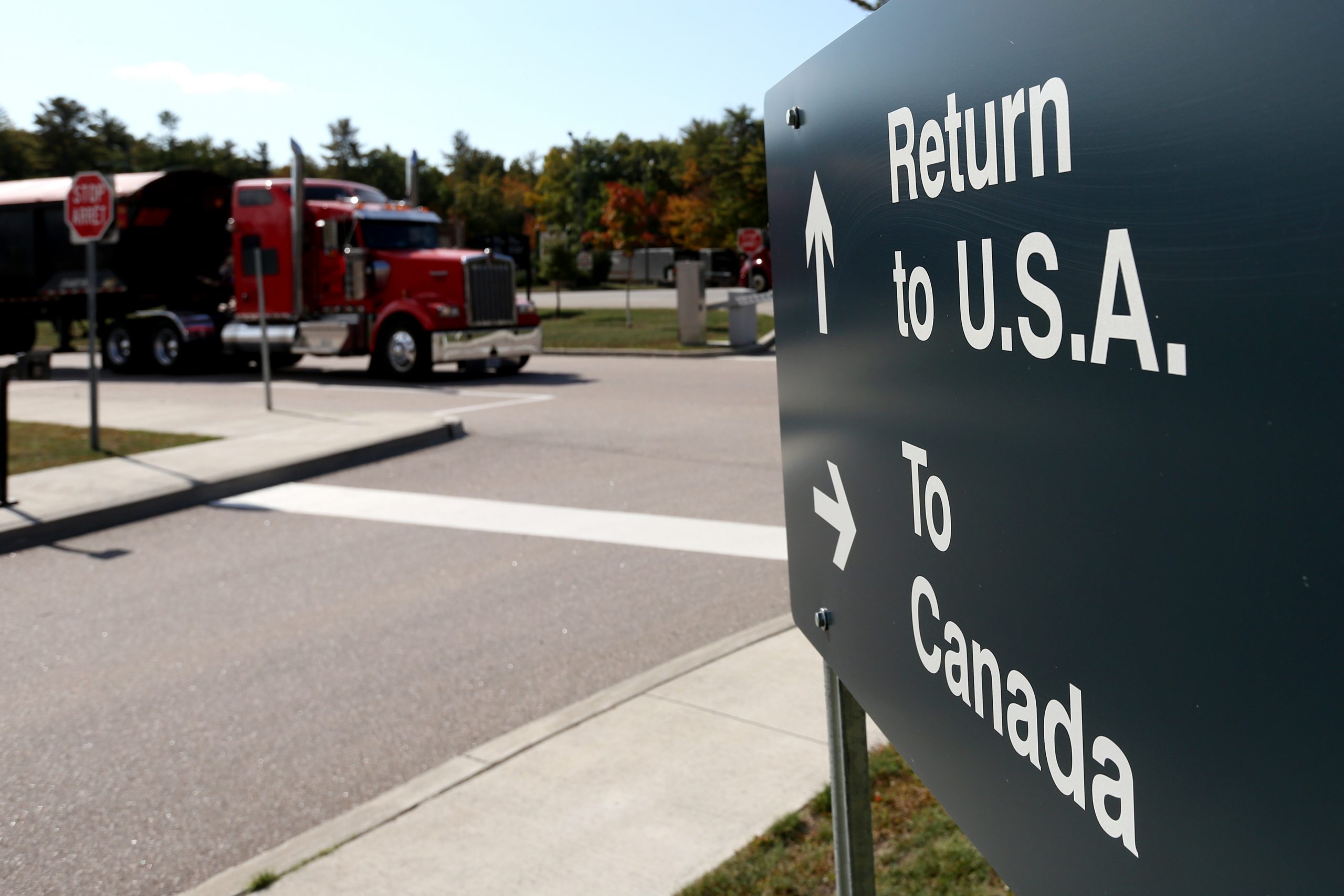
WASHINGTON — The United States will remain on the sidelines for now as Canada gamely welcomes back fully vaccinated American citizens and permanent residents.
As of midnight Sunday night, non-essential U.S. travellers who have had a full course of a Health Canada-approved COVID-19 vaccine will again be allowed on Canadian soil.
To be eligible, travellers must live in the U.S., have allowed at least 14 days to pass since their last dose and show proof of a negative molecular test for COVID-19 that’s no more than 72 hours old.
They are also required to use the ArriveCAN app or online web portal to upload their vaccination details.
Denis Vinette, vice-president of the travellers branch of the Canada Border Services Agency, says the agency learned a lot when fully vaccinated Canadian citizens were allowed to return last month.
Vinette says about half had to be turned away during the first week because they hadn’t received one of the four vaccines approved by Health Canada, or had not waited the full 14 days after their last shot.
“We found that many travellers — while they believed they met the full vaccination requirements — in fact did not, for one of two reasons,” Vinette said in an interview.
“One, it had not been a full 14 days since they’d received their second vaccination shot, and secondly, there were a lot of individuals who received a non-Health Canada vaccine who believed they would have been exempt from the quarantine requirements.”
Canada has approved four vaccines: Pfizer-BioNTech, Moderna, the Oxford-AstraZeneca shot, also known as Covishield, and the single-dose Johnson & Johnson option.
“We had a lot of individuals who didn’t have a full understanding of what applies and what does not apply,” Vinette said. “I expect the same here. I think that from a vaccination perspective, the vaccines being administered in the U.S. are approved in Canada, so I would expect that might be a lesser issue.”
The U.S., for its part, has been mum on when it might begin to ease its own restrictions on non-essential Canadian travellers at land crossings. Air, sea and rail travellers are exempt.
The White House did say last week that it is exploring whether to require discretionary visitors to be fully vaccinated when the time comes to ease restrictions, although it remains unclear whether that discussion specifically includes Canadian travellers.
The U.S. has maintained stringent travel limits on a number of foreign countries, including China, India, Ireland, Iran, South Africa, Brazil and the 26 European countries without border controls, known as the Schengen group.
The borders with Canada and Mexico, however, are widely seen as falling into a different category, in part because of the close trade ties between the three countries as well as the fact that visitors can enter without the help of a private-sector company like an airline or cruise ship operator.
Observers also detect a measure of unease in the White House at the idea of allowing travel to resume from Canada without doing so at the southern border, where an ever-present flow of would-be refugees continues to pose a political challenge for President Joe Biden.
While a short-lived labour dispute with Canadian border agents was resolved promptly last week, travellers looking to enter the country after Sunday would still be wise to pack some patience, given the likelihood that a lot of people will be getting turned away.
Some people “will not have perhaps the totality of information they require to be able to present themselves to enter the country for a discretionary purpose,” Vinette said.
“They’ll be denied entry to the country; they’ll simply be sent back to the U.S., then they can choose to comply with all requirements and then seek re-entry after that case.”
Travellers arriving by air can also expect delays, given that it already takes a lot of time.
Toronto’s Pearson International Airport, one of four in Canada that has been allowed to accept flights from outside the country, has been warning people that the international arrivals process could take more than three hours.
Canadians are growing more comfortable with air travel, which means more people in the airport, all of them dealing with augmented security and health checks thanks to COVID restrictions, said Pearson spokeswoman Beverly MacDonald.
“There are a variety of factors that impact wait times upon arrival, including additional health screening due to government travel requirements, vaccination status, immigration processing, multiple flights arriving at the same time and more,” MacDonald said in a statement.
Pearson saw nearly double the number of passengers in the second quarter than during the same months in 2020 — though at an average of 11,500 a day it’s still significantly down from that quarter in 2019, when an average of 140,000 passengers flowed through the airport.
In June, the Montreal-Trudeau International Airport saw about 10 per cent of its 2019 volumes, which rose to 20 per cent in July, and they expect to see around 30 per cent in August.
“Even if we are used to attending to a far larger number of passengers in our facilities, there are longer wait times to be expected especially at the international arrivals level, depending on the time of the day,” said spokeswoman Anne-Sophie Hamel.
The federal government is currently planning to allow vaccinated visitors from outside the U.S. to return to Canada for non-essential reasons as of Sept. 7.
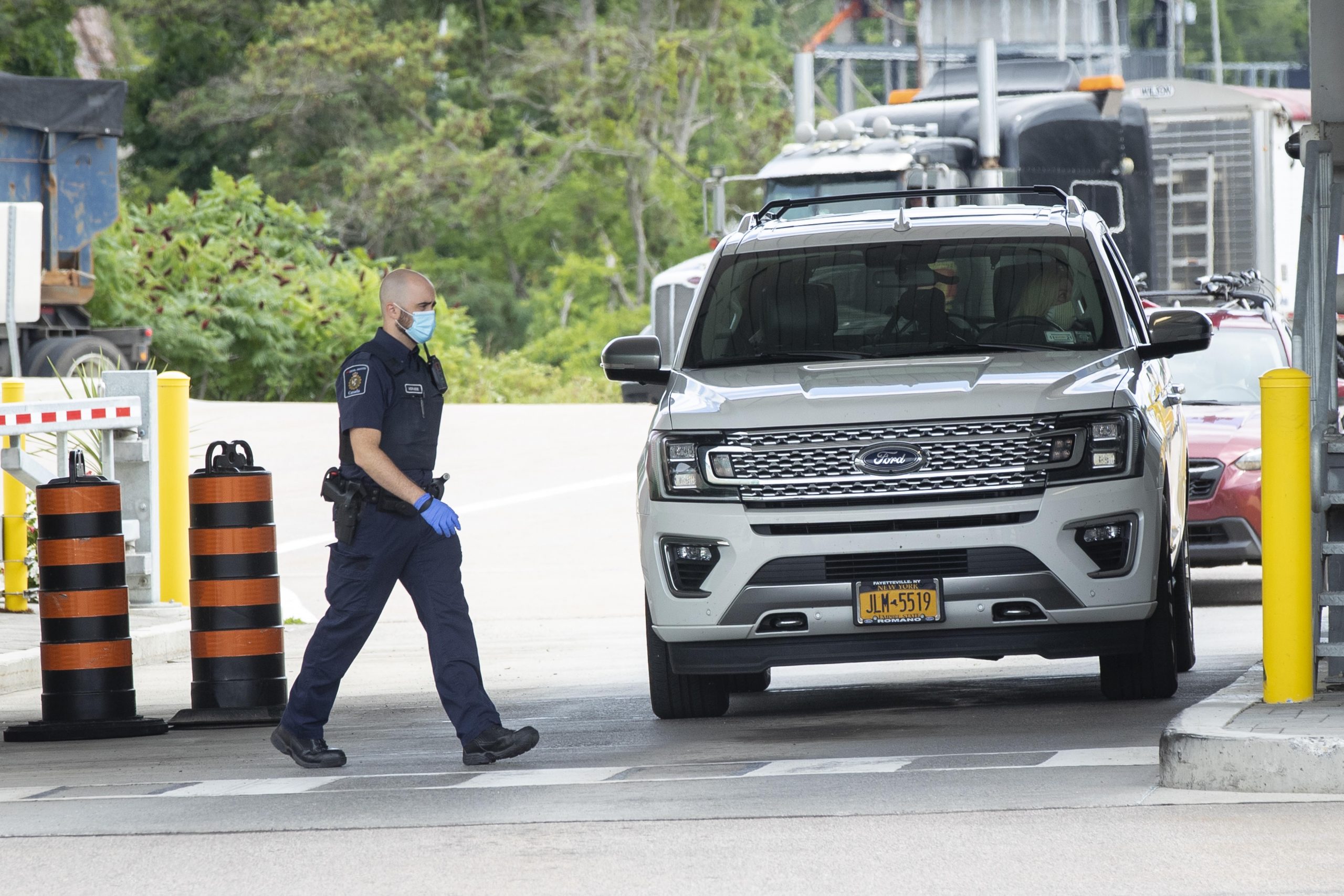
About 9,000 Canadian Border Service Agency workers are preparing to begin job action across the country today and say travellers should expect long lineups and lengthy delays at border crossings and airports.
The Public Service Alliance of Canada and its Customs and Immigration Union, which represent the workers, served a strike notice to the government on Tuesday.
If a contract isn’t reached by 6 a.m. Eastern Time Friday morning, the union has said its members will begin a “sweeping” series of actions at Canadian airports, land borders, commercial shipping ports, postal facilities and headquarters locations.
Ninety per cent of frontline border workers have been identified as essential so they will continue to offer services, if there is a strike, said the CBSA, in an email.
The CBSA “will respond quickly to any job action/work disruption in order to maintain the safety and security of our border, ensure compliance with our laws, and keep the border open to legitimate travellers and goods,” said spokesperson Jacqueline Callin.
The dispute comes as Canada is preparing to allow fully vaccinated Americans to visit without having to quarantine starting Aug. 9 and will open the country’s borders to travellers from other countries with the required doses of a COVID-19 shot on Sept. 7.
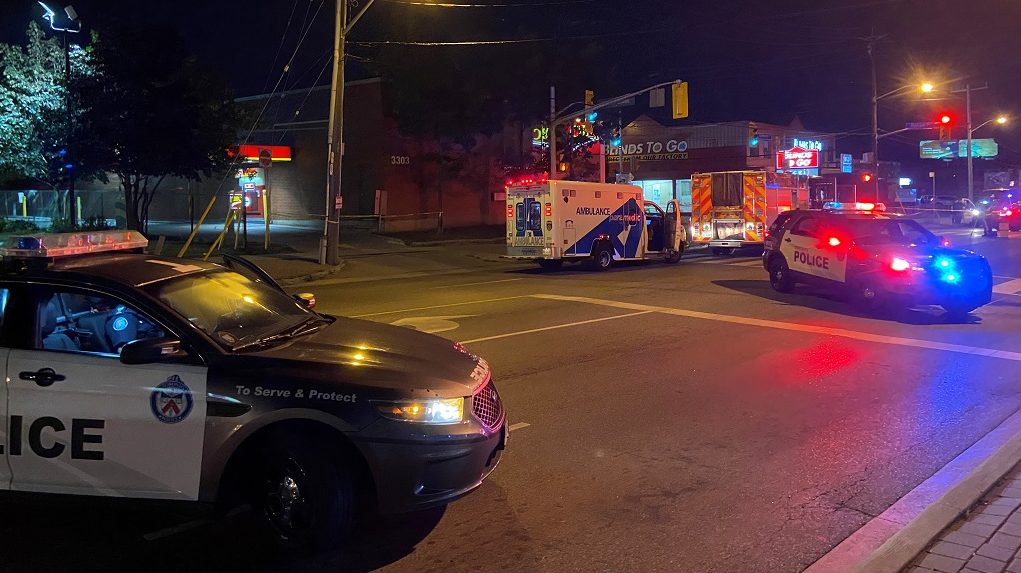
One person is dead following a crash in the Lawrence Heights area of the city.
Police were called to the area of Dufferin Street and Ranee Avenue around 11 p.m. following reports of a collision between a van and a motorcycle.
Police say the motorcyclist suffered life threatening injuries and was later pronounced dead at the scene.
It’s uncertain if the driver of the van remained on scene.
Anyone with additional information is asked to contact Traffic Services.









